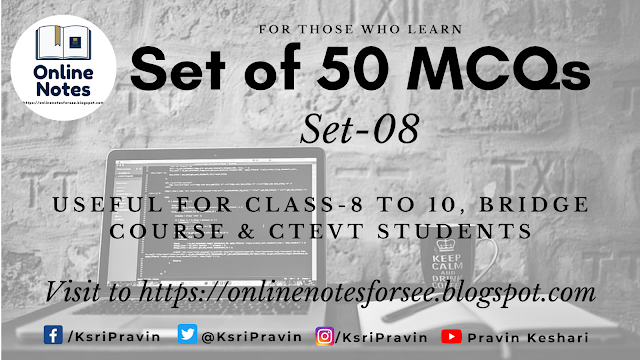Classification of Elements || Solved Q/A for S.E.E.-Exam || Part-2
Classification of Elements
Part-2
Very short questions and answers for S.E.E. students
Questions and answers to practice for S.E.E. examination
1) Write the electronic configuration of potassium in terms of sub-shell.
Answer: The electronic configuration of potassium in terms of sub-shell is K-1s² 2s² 2p⁶ 3s² 3p⁶ 4s¹.
2) In what groups do magnesium and nitrogen belong in modern periodic table?
Answer: In modern periodic table, magnesium belongs to group IIA (2) and nitrogen belongs to group VA (15).
3) What is common name given to the group I elements in the modern periodic table?
Answer: The group I of modern periodic table is commonly named as 'alkali metals' as they contain elements which form alkali on reacting with water.
4) In which group of modern periodic table are alkaline earth metals and halogens kept?
Answer: In modern periodic table, alkaline earth metals are kept in group 2 and halogens are kept in group 17.
5) In what groups, noble gases, most reactive non-metals, most reactive metals and metalloids are placed?
Answer: In modern periodic table, inert gases are kept in 0 (zero) group, highly ractive non-metals are kept in group VIIA (17), highly reactive metals are kept in group IA (1) and metalloids are kept in group IVA (14).
6)Write down two factors that determine the reactivity of elements.
Answer: Two factors that determine the reactivity of elements are:
(i) Atomic size of the elements.
(ii) Number of electrons present in the valance shell.
7) In which periodic table, elements are arranged on the basis of increasing atomic number.
Answer: In modern periodic table, elements are arranged on the basis of increasing atomic number.
8) What are alkali metals? Write down their position in the modern periodic table. Also, state their valency.
Answer: Alkali metals are highly reactive metals having one valance electron which form strong alkalis on reacting with water. They are located in extreme left side of the modern periodic table in group I.
9) Write any two characteristics (special features) of modern periodic table.
Answer: The two characteristics of modern periodic table are:
(i) The elements are arranged in the periodic table on the basis of their electronic configurations.
(ii) The elements having the same number of electrons in valance shell are kept in the same group.
10) What are s-block elements?
Answer: The elements of group 1 and 2 of modern periodic table in which the last electron enters s-orbital are called s-block elements. Either one or two valence electrons are filled in s-orbital of s-block elements.
11) Write down the position of inner transition metals in modern periodic table.
Answer: Inner transition metals are placed in f-block of modern periodic table.
12) Write down the position of metals and non-metals in the modern periodic table.
Answer: In the modern periodic table, metals are placed on the left side whereas non-metals are placed at the top of alkali metals in group IA (1).
13) In what groups do calcium and chlorine belong in modern periodic table?
Answer: Calcium belongs to group IIA or 2 and chlorine belongs to group VIIA in the modern periodic table.
14) In what group and period does gold lies in the modern periodic table?
Answer: In modern periodic table, gold lies in group IB and 6th period.
15) What are periods? How many periods are there in modern periodic table?
Answer: Periods are the horizontal rows of elements in the modern periodic table. There are seven periods in the modern periodic table.
16) What is electronic configuration?
Answer: Electronic configuration is defined as the systematic distribution of electrons in the various shells of an atom.
17) Study the electronic configuration given below and answer the following questions on the basis of it.
1s² 2s² 2p⁶ 3s² 3p⁶ 4s¹ 3d¹⁰.
(i) Name the element and write its block.
(ii) Write the atomic number and valencies of this metal.
Answer: (i) The name of this element is copper and its block is d-block.
(ii) The atomic number of this element is 29 and its valency may be 1 or 2.
18) What are the maximum numbers of electrons that can accommodate in p and f-sub shell?
Answer: The maximum number of electrons that can accommodate in p-sub shell is 6 and that in f-sub shell is 14 .
19) State 2n² rule.
Answer: 2n² rule is the rule which determines the maximum number of electrons in a shell of an atom, where 'n' is the number of shells.
More questions will be given in another blog post.
____________________________________________________________________________________
More questions will be given in another blog post.
____________________________________________________________________________________












Very useful
ReplyDeleteThanks sir😊😊
Thank you for your concern! Keep loving, Keep visiting...
Delete#OnlineNotes
Sir please provide us answers of all the question..
Delete